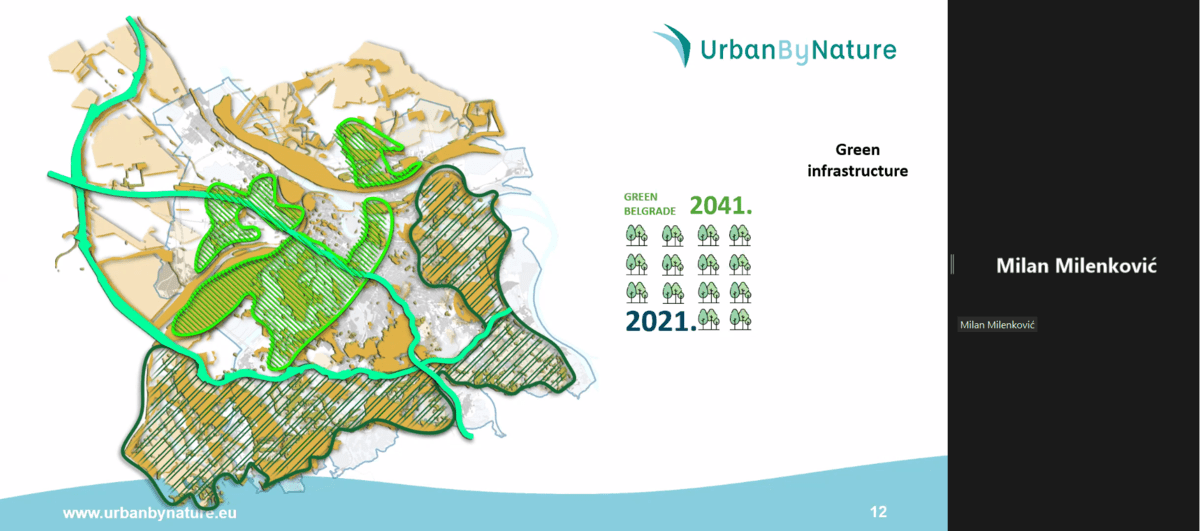UrbanByNature South Eastern Europe Hub Webinar #3 Recap: Achieving environmental and social targets through Urban Greening Plans

Achieving environmental and social targets through Urban Greening Plans
Did you miss the third edition of the UrbanByNature South Eastern Europe webinar series? Let’s briefly recap what happened:
The #3 UrbanByNature South Eastern Europe webinar addressed step 4 of the UbN programme, COMMIT & PLAN, which consists in outlining an action plan through strong participation of citizens in defining priority topics and intervention areas. The session was facilitated by Maggie Armstrong, member of the Circular Development Team, ICLEI World Secretariat.
Representing the CLEVER Cities project, Philipp LaHaela Walter, Senior Officer for Biodiversity and Green Infrastructure at ICLEI Europe, gave the first intervention of the day, introducing the European Commission’s new Urban Greening Platform and reflecting on the process of developing urban greening plans. In collaboration with Eurocities, ICLEI Europe consulted with cities to understand the status of urban biodiversity conservation and the common urban nature needs. The organizations gathered inputs from more than 100 stakeholders and conducted a couple of workshops in which they could dive into details on what an urban planning guidance should incorporate.
Philipp presented the resulting urban planning guidance materials. The initiative included the development of a toolkit which aimed at supporting cities in the implementation of urban greening plans using a co-creation based approach. Divided into 3 main stages (Preparation, Action Planning, Implementation & Monitoring), the approach includes a strong consultation process with the local communities, an analysis of the current status in terms of biodiversity and the definition of priorities, actions and targets.
In the preparation stage, it is important to guarantee the co-creation process, securing a long term political commitment to drive necessary change in the city. This facilitates the mainstreaming of urban nature. The second step is to design a working structure that ensures participation across departments with the necessary skills. It is then important to establish a co-creation process, including all key stakeholders, which means reaching out to different sectors and levels of governments, gathering collective power around the initiative.
The action planning stage is the biggest part of such planning, which includes the development of long-term vision and goals and the analysis of current status of green spaces in the city. This baseline assessment will serve as the basis to the ensuing steps that aim to set indicators and targets and the establishment of priorities, actions, responsibilities and timeline. As a result, the city will have a detailed action plan, which also includes financing options to facilitate the process. This stage is finalized with a communication strategy that raises awareness of the community and helps in building capacity to contribute to the common goals.
The implementation and monitoring stage will complement the planning process with the establishment of monitoring, reporting and evaluation systems.
In the second intervention of the day, Elissavet Bargianni, Climate Change Adaptation Coordinator of the Resilience & Sustainability Department in the City of Athens, focused on presenting the plans and initiatives of the City ofAthens to address climate adaptation.
She set the scene with a general context on Athens’ resilience strategy and climate action plan, signed in 2017 and how this plan was updated this year to fulfill the needs of the city, making it more resilient and carbon neutral. In the current version, the Climate Action Plan outlines actions focused on ambitious adaptation goals such as the increase of green coverage up to 30% by 2030.
Elissavet also presented some programs that the city is currently engaged in, such asThe Athens Resilient City and Natural Capital program. Funded by the European Bank for Reconstruction and Development (EBRD), the project focuses on creating green spaces with NBS and creating green corridors for the cities in 3 local neighborhoods. She highlighted the co-creation aspect of the initiative, which included a consultation process and a questionnaire in which citizens could express their opinion regarding the project. Additionally, the city accessed technical assistance on green buildings from EBRD, which worked to incorporate adaptation and landscape plans into building design. According to Elissavet, this support can be seen as a “system of operations” since it can lead to further development of corridors and interactions among civil society groups, such as children and teachers.
Milan Milenković,representative of the Secretariat of Environmental Protection of the City of Belgrade, Serbia, concluded the webinar with local insights from the experiences of the City of Belgrade. He emphasized how the city includes urban plans and green plans in the local legislation.
At the moment, Belgrade is working on a green city action plan which mainstreams climate adaptation and resilience. The plan included a consultation process and workshops that incorporated Clever Cities’ concepts into their local procedures. The plan is divided into 4 themes, namely Energy and Efficiency, Urban Planning and Mobility, Water and Waste and Greening and Resilience. All categories mainstream adaptation and resilience into their policies and activities.
Milan also shared some of the remaining environmental challenges to be addressed by urban green planning. For instance, flood management, erosion control, and limited green areas are key issues to be addressed in recent plans.
In the discussion session, the audience had the chance to ask questions and hear from the panelists about their experience on the ground. Philip shared his experience with co-creation, emphasizing the importance of engaging key stakeholders in the process. He said that it is powerful due to the local knowledge, cultural and historic background. Elissavet complemented the discussion by underscoring the importance of having various groups of stakeholders in discussions about green infrastructure. Engaging with groups from academia, private sector work and local communities can strengthen the planning process and lead to further engagement by creating alliances, combining expertise, and collaboratively searching for funding tools.
The webinar recording is available on the CitiesWithNature Youtube Channel. For more information on upcoming events and to receive our monthly UrbanByNature Digest, we encourage you to fill out the UrbanByNature registration form.
The next UrbanByNature South Eastern Europe webinar will take place on 06 December. The session will explore step 5 / IMPLEMENT of the UrbanByNature methodology - stay tuned and thank you for joining us!

Our partners












The UrbanByNature programme is funded by the Horizon 2020 Framework Programme of the European Union under Grant Agreements No. 730222 and No. 776604. It has received funding for an update by the Horizon Europe Programme under the Grant Agreement No 101003818. The sole responsibility for the content of this website lies within UrbanByNature and in no way reflects the views of the European Union.